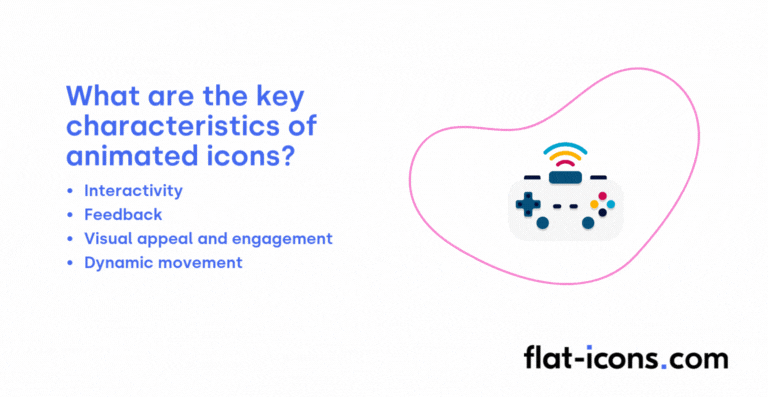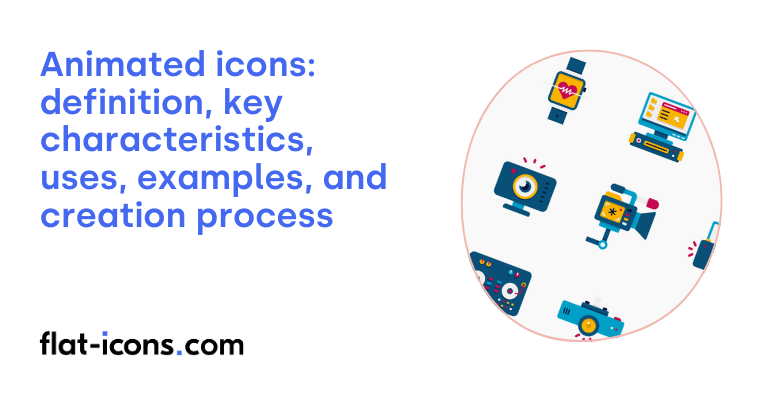Animated icons are visual symbols that use movement to communicate meaning, provide feedback on user actions, or enrich the user experience.
The key characteristics of animated icons are interactivity, feedback, visual appeal and engagement, and dynamic movement.
Animated icons are typically used in website navigation and interaction, mobile app feedback and guidance, loading and status indicators, interactive UI elements, enhancing visual storytelling, and software interfaces.
Table of Contents
What are animated icons?
Animated icons are visual symbols that use movement to communicate meaning, provide feedback on user actions, or enrich the user experience. They represent a step forward from static icons, introducing a dynamic icon style to visual communication. In essence, animated icons can guide the user’s focus and clearly indicate the action associated with the icon, effectively turning traditional, passive icons into more engaging visual cues within a digital interface.
The development of animated icons has been significantly influenced by advancements in technology. Early implementations often relied on the GIF format. While GIFs were suitable for basic animations, their large file sizes presented challenges, particularly concerning page loading speeds. However, the landscape of animated icons has been transformed by the emergence of newer formats such as Lottie (which is JSON-based), SVG, and optimized MP4. These contemporary formats offer significant advantages, including smaller file sizes, improved scalability, and greater flexibility for customization.
Consequently, animated icons have become increasingly popular among UI designers. This growing adoption reflects a deeper appreciation for the role of motion in enhancing digital design and user interaction.
What are the key characteristics of animated icons?

The key characteristics of animated icons are listed below.
- Interactivity: Animated icons often respond to user actions like mouse hover or clicks, providing dynamic feedback and enhancing user engagement.
- Feedback: These icons offer immediate visual confirmation of user actions or system states, such as loading, success, or errors.
- Visual appeal and engagement: Animation captures user attention and adds a layer of visual interest and personality to interfaces, improving the overall user experience.
- Dynamic movement: Unlike static icons, animated icons use motion and visual changes over time to convey meaning or draw attention.
Where are animated icons typically used?
Animated icons are typically used as listed below.
- Website navigation and interaction: Used to draw attention to call-to-action buttons, guide users through website structures, and enhance navigation menus.
- Mobile app feedback and guidance: Employed to indicate updates, notifications, and guide users through tutorials, providing visual cues for user actions.
- Loading and status indicators: Utilized across various digital platforms to provide visual feedback during loading processes or to indicate different states.
- Interactive UI elements: Used in elements like toggles and switches to visually represent state changes and make interactions more engaging.
- Enhancing visual storytelling: Incorporated into presentations and videos to add visual interest, highlight key points, and improve overall engagement.
- Software interfaces: Used to highlight important functions, indicate status, and provide visual feedback within desktop and web-based software applications.
When should you use animated icons?
You should use animated icons strategically to enhance user interaction by providing clear visual feedback, making interfaces more intuitive and responsive. They can effectively draw attention to key features, subtly guide users through processes, and add a layer of personality that reinforces brand identity.
Animated icons are particularly useful for conveying actions or processes and indicating feedback about operations, especially when an icon needs to respond to user interaction. Effective animation increases user immersion and ease of use, making digital experiences more intuitive in task-focused scenarios and more engaging in play-focused contexts.
Motion within animated icons can also direct users to important elements like calls to action. Ultimately, animated icons can boost engagement and lower bounce rates by making pages more visually appealing and interactive, but their use should always be purposeful and directly contribute to enhancing the user experience.
What are the pros and cons of using animated icons?
The pros of using animated icons are listed below.
- Enhanced user engagement and feedback: Animated icons can make interfaces more interactive and provide clear visual feedback to the user.
- Improved user guidance and comprehension: They can draw attention to important elements, guide navigation, and visually demonstrate actions for better understanding.
- Reinforced brand personality: Unique and well-designed animations can add character to a brand and strengthen its identity
The cons of using animated icons are listed below.
- Potential for distraction and performance issues: Poorly implemented or excessive animations can be distracting, overwhelming, and negatively impact website or app performance.
- Accessibility challenges: Animations can be harmful for users with motion sensitivities or attention deficit disorders and may create other accessibility barriers if not implemented carefully.
- Risk of inconsistency and negative perception: Inconsistent animation styles can confuse users, and unrealistic animations can feel unprofessional or undermine trust.
What are some examples of animated icons?
Some examples of animated icons are listed below.
- Loading indicators: A spinning circle, a series of bouncing dots, or a progress bar that fills up.
- Interactive buttons: A button that subtly changes color or size when hovered over or clicked.
- Menu icons: A “hamburger” menu icon that animates into an “X” or back arrow when the menu is opened or closed.
- Notification badges: A small bell icon that briefly shakes or pulses when a new notification arrives.
- Scrolling arrows: Arrows that gently move up or down to indicate that there is more content to scroll.
- Weather icons: A sun icon with radiating lines, a cloud with falling raindrops, or a snowflake that gently drifts.
- Volume control: A speaker icon with sound waves that expand or contract to reflect the volume level.
- Heart like button: A heart outline that fills with color and might briefly scale up or emit small bursts of color when liked.
- Message sent icon: A paper airplane icon that animates as if it’s flying away.
- Download progress: An arrow pointing downwards into a box that gradually fills up to show download completion.
How do you create animated icons?

You create animated icons by following the step-by-step guide below.
- Design your static icon first: Before you can animate an icon, you need to have a well-designed static version as your starting point.
- Choose an animation style: Decide what kind of animation you want to create. Will it be a simple transition, a looping animation, or something more complex? Having a clear idea will guide your process.
- Select animation software: There are various software options available for creating animated icons, including Adobe After Effects, LottieFiles, Haiku Animator, and even web technologies like CSS and JavaScript. Choose the one that best suits your skills and the desired output.
- Import your icon: Bring your static icon file (usually in a vector format like svg or ai) into your chosen animation software.
- Break down your icon into layers: To animate different parts of your icon independently, you’ll need to separate its elements into different layers within the animation software. For example, if you have an icon of a lightbulb, you might have separate layers for the bulb, the filament, and the base.
- Animate individual elements: Using the tools in your animation software, start animating the different layers. This might involve changing their position, scale, rotation, opacity, or other properties over time.
- Set keyframes and timing: Keyframes mark specific points in time where the properties of your layers are set. By adjusting the values of these properties at different keyframes and controlling the timing between them, you define the animation’s movement and speed.
- Refine the animation: Review your animation and make adjustments as needed. Pay attention to the pacing, smoothness, and overall visual appeal. You might need to tweak keyframe positions, easing curves, or the timing of different elements.
- Consider looping (if applicable): If you want your icon to animate continuously, ensure that the first and last frames of your animation create a seamless loop.
- Optimize for performance: Keep your animations lightweight, especially if they’re for web or mobile use. Avoid overly complex animations or excessive file sizes.
- Export in the correct format: Depending on where you intend to use your animated icon, export it in the appropriate format. Common formats include lottie json (for web and apps), gif (for simple animations), mp4 or webm (for video), or even css animations.
- Test your animated icon: Before finalizing, test your animated icon in its intended environment to ensure it plays correctly and looks as expected.
Read more icon articles
